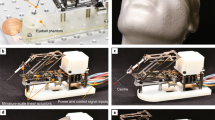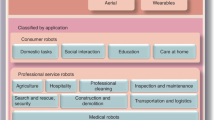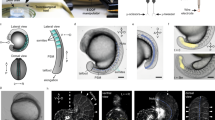Abstract
Cranial microsurgery is an essential procedure for accessing the brain through the skull that can be used to introduce neural probes that measure and manipulate neural activity. Neuroscientists have typically used tools such as high-speed drills adapted from dentistry to perform these procedures. As the number of technologies available for neuroscientists has increased, the corresponding cranial microsurgery procedures to deploy them have become more complex. Using a robotic tool that automatically performs these procedures could standardize cranial microsurgeries across neuroscience laboratories and democratize the more challenging procedures. We have recently engineered a robotic surgery platform that utilizes principles of computer numerical control (CNC) machining to perform a wide variety of automated cranial procedures. Here, we describe how to adapt, configure and use an inexpensive desktop CNC mill equipped with a custom-built surface profiler for performing CNC-guided microsurgery on mice. Detailed instructions are provided to utilize this ‘Craniobot’ for performing circular craniotomies for coverslip implantation, large craniotomies for implanting transparent polymer skulls for cortex-wide imaging access and skull thinning for intact skull imaging. The Craniobot can be set up in <2 weeks using parts that cost <$1,500, and we anticipate that the Craniobot could be easily adapted for use in other small animals.
This is a preview of subscription content, access via your institution
Access options
Access Nature and 54 other Nature Portfolio journals
Get Nature+, our best-value online-access subscription
$29.99 / 30 days
cancel any time
Subscribe to this journal
Receive 12 print issues and online access
$259.00 per year
only $21.58 per issue
Buy this article
- Purchase on Springer Link
- Instant access to full article PDF
Prices may be subject to local taxes which are calculated during checkout











Similar content being viewed by others
Code availability
We have made the control software available with this article as Supplementary Software 1. Furthermore, a MATLAB version of the same is available at our GitHub repository: www.github.com/bsbrl. We will post updated versions of the software at this location.
References
Jun, J. J. et al. Fully integrated silicon probes for high-density recording of neural activity. Nature 551, 232 (2017).
Shobe, J. L., Claar, L. D., Parhami, S., Bakhurin, K. I. & Masmanidis, S. C. Brain activity mapping at multiple scales with silicon microprobes containing 1,024 electrodes. J. Neurophysiol. 114, 2043–2052 (2015).
Scholvin, J. et al. Close-packed silicon microelectrodes for scalable spatially oversampled neural recording. IEEE Trans. Biomed. Eng. 63, 120–130 (2016).
Berényi, A. et al. Large-scale, high-density (up to 512 channels) recording of local circuits in behaving animals. J. Neurophysiol. 111, 1132–1149 (2014).
Voigts, J., Siegle, J., Pritchett, D. L. & Moore, C. I. The flexDrive: an ultra-light implant for optical control and highly parallel chronic recording of neuronal ensembles in freely moving mice. Front. Syst. Neurosci. 7, 8 (2013).
Wentz, C. T. et al. A wirelessly powered and controlled device for optical neural control of freely-behaving animals. J. Neural Eng. 8, 046021 (2011).
Kim, T. I. et al. Injectable, cellular-scale optoelectronics with applications for wireless optogenetics. Science 340, 211–216 (2013).
Jeong, J. W. et al. Wireless optofluidic systems for programmable in vivo pharmacology and optogenetics. Cell 162, 662–674 (2015).
McCall, J. G. et al. Preparation and implementation of optofluidic neural probes for in vivo wireless pharmacology and optogenetics. Nat. Protoc. 12, 219–237 (2017).
Dzirasa, K., Fuentes, R., Kumar, S., Potes, J. M. & Nicolelis, M. A. L. Chronic in vivo multi-circuit neurophysiological recordings in mice. J. Neurosci. Methods 195, 36–46 (2011).
Stringer, C. et al. Spontaneous behaviors drive multidimensional, brainwide activity. Science 364, 255 (2019).
Sofroniew, N. J., Flickinger, D., King, J. & Svoboda, K. A large field of view two-photon mesoscope with subcellular resolution for in vivo imaging. Elife 5, e14472 (2016).
Stirman, J. N., Smith, I. T., Kudenov, M. W. & Smith, S. L. Wide field-of-view, multi-region, two-photon imaging of neuronal activity in the mammalian brain. Nat. Biotechnol. 34, 857–862 (2016).
Jeong, D. C., Tsai, P. S. & Kleinfeld, D. All-optical osteotomy to create windows for transcranial imaging in mice. Opt. Express 21, 23160 (2013).
Kim, T. H. et al. Long-term optical access to an estimated one million neurons in the live mouse cortex. Cell Rep. 17, 3385–3394 (2016).
Pak, N. et al. Closed-loop, ultraprecise, automated craniotomies. J. Neurophysiol. 113, 3943–3953 (2015).
Pohl, B. M., Schumacher, A. & Hofmann, U. G. Towards an automated, minimal invasive, precision craniotomy on small animals. In 2011 5th International IEEE/EMBS Conference on Neural Engineering, NER 2011 302–305 (IEEE, Piscataway, NJ, USA, 2011).
Loschak, P. et al. Cranial drilling tool with retracting drill bit upon skull penetration. J. Med. Devices 6, 017522 (2012).
Ghanbari, L. et al. Craniobot: a computer numerical controlled robot for cranial microsurgeries. Sci. Rep. 9, 1023 (2019).
Kodandaramaiah, S. B. et al. Multi-neuron intracellular recording in vivo via interacting autopatching robots. eLife 7, e24656 (2018).
Allen, B. D. et al. Automated in vivo patch-clamp evaluation of extracellular multielectrode array spike recording capability. J. Neurophysiol. 120, 2182–2200 (2018).
Shih, A. Y., Mateo, C., Drew, P. J., Tsai, P. S. & Kleinfeld, D. A polished and reinforced thinned-skull window for long-term imaging of the mouse brain. J. Vis. Exp. 3742 (2012).
Ghanbari, L. et al. Cortex-wide neural interfacing via transparent polymer skulls. Nat. Commun. 10, 1500 (2019).
Hultman, R. et al. Brain-wide electrical spatiotemporal dynamics encode depression vulnerability. Cell 173, 166–180 (2018).
Sych, Y., Chernysheva, M., Sumanovski, L. T. & Helmchen, F. High-density multi-fiber photometry for studying large-scale brain circuit dynamics. Nat. Methods 16, 553–560 (2019).
Kim, C. K. et al. Simultaneous fast measurement of circuit dynamics at multiple sites across the mammalian brain. Nat. Methods 13, 325–328 (2016).
Siegle, J. H. et al. Open Ephys: an open-source, plugin-based platform for multichannel electrophysiology. J. Neural Eng. 14, 045003 (2017).
Mathis, A. et al. DeepLabCut: markerless pose estimation of user-defined body parts with deep learning. Nat. Neurosci. 21, 1281–1289 (2018).
Ghosh, K. K. et al. Miniaturized integration of a fluorescence microscope. Nat. Methods 8, 871–878 (2011).
Cai, D. J. et al. A shared neural ensemble links distinct contextual memories encoded close in time. Nature 534, 115–118 (2016).
Skocek, O. et al. High-speed volumetric imaging of neuronal activity in freely moving rodents. Nat. Methods 15, 429–432 (2018).
de Groot, A. et al. NINscope: a versatile miniscope for multi-region circuit investigations. eLife 9, e49987 (2020).
Srinivasan, S. et al. Miniaturized microscope with flexible light source input for neuronal imaging and manipulation in freely behaving animals. Biochem. Biophys. Res. Commun. 517, 520–524 (2019).
Liang, B., Zhang, L., Moffitt, C., Li, Y. & Lin, D. T. An open-source automated surgical instrument for microendoscope implantation. J. Neurosci. Methods 311, 83–88 (2019).
Khaw, I. et al. Flat-field illumination for quantitative fluorescence imaging. Opt. Express 26, 15276–15288 (2018).
Adam, Y. et al. Voltage imaging and optogenetics reveal behaviour-dependent changes in hippocampal dynamics. Nature 569, 413–417 (2019).
Holtmaat, A. et al. Long-term, high-resolution imaging in the mouse neocortex through a chronic cranial window. Nat. Protoc. 4, 1128 (2009).
Drew, P. J. et al. Chronic imaging and manipulation of cells and vessels through a polished and reinforced thinned-skull. Nat. Methods 7, 981–984 (2010).
Alieva, M., Ritsma, L., Giedt, R. J., Weissleder, R. & van Rheenen, J. Imaging windows for long-term intravital imaging. Intravital 3, e29917 (2014).
Kawakami, M. & Yamamura, K. I. Cranial bone morphometric study among mouse strains. BMC Evol. Biol. 8, 73 (2008).
Dana, H. et al. Thy1-GCaMP6 transgenic mice for neuronal population imaging in vivo. PLoS One 9, e108697 (2014).
Feng, G. et al. Imaging neuronal subsets in transgenic mice expressing multiple spectral variants of GFP. Neuron 28, 41–51 (2000).
Kozlowski, C. & Weimer, R. M. An automated method to quantify microglia morphology and application to monitor activation state longitudinally in vivo. PLoS One 7, e31814 (2012).
Acknowledgements
S.B.K. acknowledges funds from the Mechanical Engineering Department, College of Science and Engineering, MnDRIVE RSAM initiative of the University of Minnesota, Minnesota Department of Higher Education and NIH 1R21NS103098-01, 1R01NS111028, 1R34NS111654, 1R21NS112886 and 1R21 NS111196. L.G. was supported by the University of Minnesota Informatics Institute’s (UMII) graduate fellowship. We thank Dr. Eric Yttri, Alan Lai and Mark Nicholas of the Yttri laboratory at Carnegie Mellon University for useful feedback during beta-testing of the Craniobot. We also thank Luiz Bueno and Dr. York Winter of labmaker.org, who provided insights and suggested improvements to streamline hardware assembly. We also thank Dr. Spencer Smith (@Labrigger) for discussions on automated technologies for cranial microsurgeries and the strategies for wide adoption of such technologies, which partially motivated the documentation of this protocol.
Author information
Authors and Affiliations
Contributions
M.L.R., L.G., D.S.S., M.L., P.S. and S.B.K. developed the hardware systems. D.S.S. and L.G. developed the Python-based software GUI. M.L.R., S.L. and S.B.K. tested the complete system. M.L.R., L.G., D.S.S., S.L., M.L., J.D., Z.S.N., P.S. and S.B.K. wrote the manuscript.
Corresponding author
Ethics declarations
Competing interests
The authors declare no competing interests.
Additional information
Peer review information Nature Protocols thanks Jasmin Hefendehl and the other, anonymous, reviewer(s) for their contribution to the peer review of this work.
Publisher’s note Springer Nature remains neutral with regard to jurisdictional claims in published maps and institutional affiliations.
Related links
Key references using this protocol
Ghanbari, L. et al. Sci. Rep. 9, 1023 (2019): https://doi.org/10.1038/s41598-018-37073-w
Ghanbari, L. et al. Nat. Commun. 10, 1500 (2019): https://doi.org/10.1038/s41467-019-09488-0
Supplementary information
Supplementary Video 1
Video demonstrating the use of the Craniobot to perform a 3-mm-diameter circular craniotomy centered at 2 mm to the right of and 2 mm posterior to Bregma.
Supplementary Software 1
Setup file for installing and using the Craniobot control software.
Supplementary Software 2
Setup file for installing and using the Arduino microcontroller.
Supplementary Data 1
A compressed file archive consisting of all computer-aided design (CAD) files of custom-fabricated components needed for assembly of the Craniobot and the surface profiler.
Supplementary Data 2
A file containing the code for the microcontroller to regulate the switching circuit.
Supplementary Data 3
A compressed file archive consisting of .csv files for performing craniotomy over the whole dorsal cortex and a rectangular craniotomy.
Supplementary Data 4
A compressed file archive consisting of all CAD files required for assembly of the See-Shell implant.
Rights and permissions
About this article
Cite this article
Rynes, M.L., Ghanbari, L., Schulman, D.S. et al. Assembly and operation of an open-source, computer numerical controlled (CNC) robot for performing cranial microsurgical procedures. Nat Protoc 15, 1992–2023 (2020). https://doi.org/10.1038/s41596-020-0318-4
Received:
Accepted:
Published:
Issue Date:
DOI: https://doi.org/10.1038/s41596-020-0318-4
This article is cited by
-
Transparent neural interfaces: challenges and solutions of microengineered multimodal implants designed to measure intact neuronal populations using high-resolution electrophysiology and microscopy simultaneously
Microsystems & Nanoengineering (2023)
-
Miniaturized head-mounted microscope for whole-cortex mesoscale imaging in freely behaving mice
Nature Methods (2021)
-
Whole-brain functional ultrasound imaging in awake head-fixed mice
Nature Protocols (2021)
Comments
By submitting a comment you agree to abide by our Terms and Community Guidelines. If you find something abusive or that does not comply with our terms or guidelines please flag it as inappropriate.



